Abstract
Transfer of training from an instructional environment to a natural environment may bring about ineffective language performance by bilingual individuals. In that regard, this study was designed to demonstrate the effect of such a transition on individuals' language performance. A series of Japanese and English words were used as sample and comparisons in a matching procedure. Differential conditioning was implemented in the presence two types of contextual stimuli. After three sets of relations were established, the physical configuration of the contextual stimuli was changed to more subtle appearances, and the number of variations in the contextual stimuli was increased. Measures of percent correct and response latency were used to show the negative influence on second language performance. Percent correct responses decreased with the subtle contextual stimuli for 11 out of 14 participants, and average response latency increased with the increased number of variations in the last phase. These findings indicate that the change in environmental stimuli will be a significant participatory factor in training of second languages.
Keywords: contextual control, conditional discrimination, second language performance
INTRODUCTION
Second Language Education Literature
Recently, the importance of learning environments has stirred debate within the domain of second language acquisition (Collentine & Freed, 2004). Many language teachers and learners claim that English-as-a-second-language (ESL) students do not perform as well in class situations where communication is required as in those where only grammar learning is required, not to mention using their learned repertoire in a non-instructional setting (Larsen-Freeman, 2003).
In a study that focused on second language use in natural contexts, MacWhinney (1997) questioned the value of explicit grammar instruction. He defined explicit instruction as teaching a set of grammar rules to be used in classroom settings, and contrasted this with experiential learning in natural settings.
The following introduces the literature in second language education that involves manipulation in ESL classrooms and/or in quasi-natural environments. Liu (1995) investigated the effects of contextual cues (i.e., definition, part-of-speech, sentence examples, videotape, and relationship) on adult second language learning, and showed a significant effect on both acquisition and performance. Kang (1995) compared the effects of different kinds of contexts, human instructor, computer aid, computer with picture aid, and computer with situational context aid. The computer with situational context aid condition (CC condition) displayed a situational context (e.g., a picture, in which a boy is brushing his teeth), which included multiple words associated with parts of the context. Results indicated that the participants in the CC condition outperformed others in learning vocabulary and also with a statistically significant difference in retention scores.
The previous research focused on second language repertoires in ESL classroom contexts. The following is a study of the importance of the external environment (e.g., natural contexts) for second language learning and performance.
Literature on Second Language and Focus on Natural Contexts
A number of studies have focused on the role and importance of interaction with and exposure to natural contexts (Mackey & Oliver, 2002; Lochtman, 2002). Collentine and Freed (2004) reviewed the literature and found different influences of two types of situations: “domestic immersion learning context” and “study abroad learning context.” The study abroad context consists in learning the second language in the target culture by living with a host family. The domestic immersion context consists in learning the second language along with the first language—which would only be possible as an intervention with very young children, or which could be studied in retrospect with adults or children who had been exposed to this situation as children. In general, survey data (self report or questionnaire) shows that students who are exposed to the study-abroad-learning context tend to develop oral fluency to a greater degree than those in the other context, although this is in no way an experimental or controlled comparison.
Some studies have introduced special terminology for certain aspects of conversations in natural contexts (Trillo, 2002; Vesterbacka,1991; Bouton, 1994; Kecskes, 2000). Huckin and Jin (1986) introduced the term “contextualization” for experiencing words in a natural setting. In their experiment, a “contextualization” group received instruction in how to guess the meaning of unfamiliar words in context with other words and sentences on a newspaper, and performed significantly better on a vocabulary test than a control group.
A substantial portion of the behavior analytic literature in the next section focuses on the effect of environmental stimuli on directly observable behavioral measurements.
Behavior Analysis Literature
The next two studies experimentally manipulated environmental stimuli to study their influence on second language acquisition and performance (Herbst, Houmanfar, & Washio, 2003; Houmanfar, Hayes, & Herbst, 2005). They were concerned with optimal conditions for second language acquisition by ESL students, and in particular with the correct the use of articles (the and a). Explicit rule instructions (clear and simple rules systematically and actively conveyed verbally) were compared with implicit learning (no rules prior to making responses, but feedback after a response was made). The study did not produce a clear result in terms of the type of condition that was most effective for learning the use of articles.
Houmanfar et al. (2005) developed an analog design for a bilingual repertoire with domination of “first language” and its interference with “second language.” These phenomena were demonstrated with two sets of conditional equivalence relations under different contextual conditions (background colors) as arbitrary languages. Equivalence relations analogous to the first language were learned prior to the other relations that were analogous to the second language, with some stimuli shared by both sets. Dominance of the first language was demonstrated by examining participants' percent correct and response latency in the presence and absence of the background colors. Interference by one language with the other was modeled by comparing the degree to which resurgence of the first language and the second language would occur in extinction, and following a period of exposure to inconsistent test trials. Results demonstrated the establishment of both phenomena. More specifically, dominance of the first language was indicated by more response to the equivalence relations as the first language in the absence of the background colors, and its interference was shown by more response to the equivalence relations associated with the first language during the resurgence period.
Although not directly found in the second language and its education, some literature in behavior analysis is concerned with training animals or humans for conditional discrimination under specific conditions and has studied the function of contextual control in the development of stimulus relations (Bush, Sidman, & Rose, 1989; Dibbets, Maes, & Vossen, 2002; Dougher, Perkins, Greenway, Koons, & Chiasson, 2002; Green, 1986; Griffee & Dougher, 2002; Hayes, Kohlenberg, & Hayes, 1991; Sidman & Tailby, 1982; Steele & Hayes, 1991; Swartzentruber, 1993; Wulfert & Hayes, 1988).
Sidman and Tailby (1982) successfully used the matching-to-sample procedure for children to learn conditional relations between stimuli. Wulfert and Hayes (1988) employed colors on the screen periphery (red and green) as contextual stimuli that controlled switching consequential functions of reinforcement and punishment and succeeded in controlling participants' performance in accord with the different screen periphery colors. Bush, Sidman, and Rose (1989) used high and low tones as contextual stimuli to control visual conditional discrimination learning by human subjects, resulting in successful formation of two sets of equivalence classes under the control of contextual stimuli. Steele and Hayes (1991) trained nine human subjects to respond differentially to geometric figures under three different kinds of contextual stimuli (i.e., same, different, and opposite). In testing for direct as well as derived relations between the stimuli, the subjects' performance was reliably under the control of the contextual stimuli. Swartzentruber (1993) trained pigeons to respond in the presence of two different contextual stimuli via the autoshaping procedure. Experiment 1 had a consistent association between the combination of a contextual stimulus and a conditioned stimulus and reinforcement, and Experiment 2 switched the association in the second phase (e.g., CS:X and contextual stimulus:A → reinforcement in the first phase, and this combination of the CS and contextual stimulus switched to non-reinforcement). In testing, the pigeons trained in Experiment 2 showed higher correct responding when the association was switched. In Griffee and Dougher (2002), three background colors (red, green, and yellow) were used as contextual stimuli to train conditional discriminations between triangle shapes, button position, and nonsense syllables, with successful training results.
Analysis of Two Different Environments
Most of the previously mentioned second language literature shows that there is a transfer between two different environments involved when second language learners are in the process of acquiring or performing a second language repertoire in natural contexts. The word “context,” often used in the second language literature, has different connotations, such as referring to an environment itself or to specific objects or stimuli in an environment. In this study, “context” refers to specific stimuli within each environment. The instructional environment usually provides salient contexts to support learning, such as pictures, slow and clear-cut questions from teachers, simple sentences in textbooks, or objects used for teaching. On the contrary, the natural environment does not usually present simple and salient contexts in casual discourse. Rather, people refer to objects that are distant and out of sight and refer to events that occurred in the distant past or in an unclear temporal context. It is quite reasonable to assume that the transfer from instructional to natural environment will negatively affect second language performance. Serna and Perez-Gonzalez (2003) demonstrated the necessity of training conditional discrimination of stimulus relations along with contextual stimuli prior to testing such discriminations. The current study supported the assumption that sudden transfer between the two distinct environments without any directly relevant training will affect performance in a negative manner.
The current study used the behavior analytic methodology of conditional discrimination to demonstrate change in response accuracy and response latency within the context of change in environmental stimuli. Accordingly, the effects of the salience (complexity) in the environmental stimuli on performance were examined. More specifically, a series of Japanese and English words were used as sample and comparison stimuli in the matching-to-sample procedure.
Method
Participants and Setting
Participants (N = 19) in this study were college students who were 18 or older, and were enrolled in undergraduate introductory psychology courses. Each participant received three extra credit research hours for participating in three parts of the experiment. Lack of prior knowledge of Japanese language was required. All sessions were conducted in a computer laboratory.
Fourteen participants completed the experiment. Five dropped out during or after the first training and testing phases were completed. One did not complete Training Phase 1 and expressed his discouragement to return at the end of the first session. The other four did not complete Training Phase 2 during the first session and did not return to the second session. In addition, they did not provide any information to the experimenter regarding their discontinued participation in the study.
Material
A computer program created by Visual Basic.NET8 was used in the experiment. The program consisted of an experimental task, which included two different match-to-sample training phases, each of which was followed by a corresponding testing phase and two additional testing phases.
Procedure
The experiment was divided into two parts that were approximately a week apart. The first part consisted of consent form procedure, screening test, Training Phase 1, Testing Phase 1, Training Phase 2, and Testing Phase 2. The second part consisted of Testing Phase 3 and Testing Phase 4. Each participant was assigned to a small quiet room. After the participant signed a consent form, the experimenter started the computer program. Because the computer program was self-explanatory the experimenter assisted the participant only with unexpected computer problems during the experiment. With regard to questions concerning the content of the task, the experimenter repeated the corresponding part of the instruction that was introduced at the beginning of the first session. Specific instructions for each phase are described below.
Participant screening. Participants were given a computerized screening test, which included the following components. The computer screen displayed Japanese words in Roman characters (as sample stimuli), each of which was accompanied by three English words (as comparison stimuli) displayed below the Japanese words, after three seconds of delay. Only one of the English words was the correct meaning of the Japanese word. Participants were asked to select one of the three English words by mouse clicking. After 3 Japanese words and 27 English words were displayed three times respectively the session was completed. The screening session took about 10 minutes to complete. These words were randomly displayed across trials. The exclusionary criterion was if a participant chose the correct English meaning three times during the presentation. No participants were excluded from the study on this basis.
The experimental task. There were three sets of stimuli, each consisting of a Japanese word and three English words (a total of three Japanese words and nine English words). Figure 1 shows the stimuli used in the experimental task: Japanese words in Roman characters, English words as possible English translations for these Japanese words, background colors for one type of apparent contextual stimuli, and two-word sequences for the other type of apparent contextual stimuli. The two types of contextual stimuli were modified from apparent to subtle (complex) display during the latter part of the testing phase.
Figure 1.
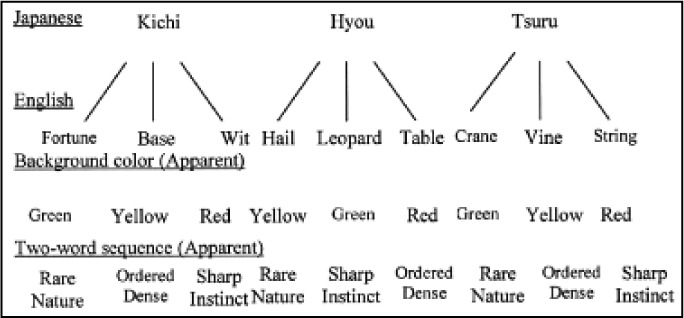
Three stimulus sets and two types of apparent contextual stimuli.
The first group of training and testing phases (Training Phase 1 and Testing Phase 1) consisted of conditional discrimination trainings for each stimulus set utilizing three background screen colors as one type of apparent contextual stimuli. The apparent contextual stimuli functioned as conditional discriminative stimuli in the task. Each Japanese word was used as a sample stimulus (A1), which had three English words as comparison stimuli (B1, B2, and B3) controlled by three background screen colors (X1, X2, and X3); that is, each English word was correct only when one of the background screen colors was displayed (i.e., X1: A1 → B1 as correct; X2: A1 → B2 as correct; X3: A1 → B3 as correct). The second training and testing phases (Training Phase 2 and Testing Phase 2) consisted of conditional discrimination trainings in each stimulus set utilizing three two-word sequences as the other type of apparent contextual stimuli. Two additional testing phases followed these two sets of training and testing phases. Testing Phase 3 tested for control of the two apparent contextual stimuli in a mixed manner. Testing Phase 4 tested for control of two subtle (complex) contextual stimuli in a mixed manner. The degree of salience or simplicity in the contextual stimuli decreased, and the variation in each contextual stimulus increased in the last phase. In all the phases except for Testing Phase 4, participants were required to make a response within six seconds in each trial, and if no response occurred the next trial began automatically. The participants were instructed about the time limit at the beginning of the training phases and Testing Phases 1, 2, and 3. The inter-trial interval was 1.5 s throughout the experiment.
During Training Phase 1, the sample stimulus (a Japanese word) was displayed on the top of a computer screen, and the participants were required to respond by selecting one of the three comparison stimuli in the presence of a contextual stimulus (i.e., a background screen color; see Figures 2 and 3). The instruction given to each participant was as follows:
The next screen will present a button with a Japanese word on the top. Then, three English words on buttons at the bottom will be presented. Please click one of the English words that you think is correct. Similar tasks will continue for a while. Try to pay attention to background colors as well. The next task will appear if you do not select an answer within six seconds. Please let the experimenter know when a dialog box says so. Please type in the subject number in the box below and click the OK button when you understand.
Figure 2.

Presented computer screen during the Training Phase 1.
Figure 3.
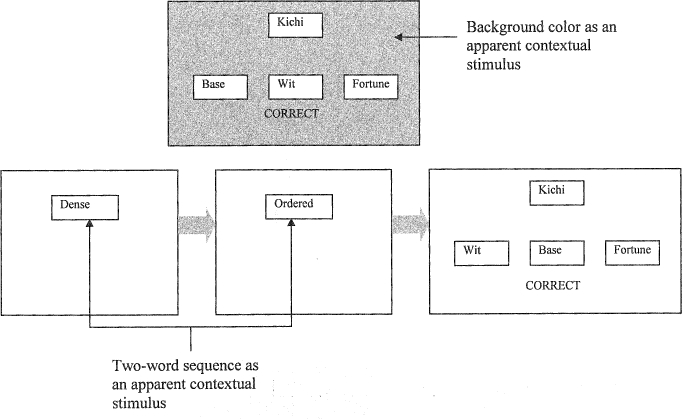
. Background color and two-word sequence for apparent contextual stimuli display.
Each of the three apparent contextual stimuli was randomly assigned to one of the English words, and the participants were required to select the correct English word for that contextual stimulus. The background screen colors on the computer screen consisted of yellow, red, and green. Following each response made by a participant, “correct” or “incorrect” was displayed at the bottom of the screen. The participants were exposed to each association of Japanese and English words six times. Participants were presented with one of the three background screen colors in two out of the six trials. The locations of the comparison stimuli as well as the order of contextual stimuli display were randomized. The total number of trials in Training Phase 1 was 54. All training trials were presented randomly, and the participants had to score 90% or higher in terms of all the stimulus associations before moving on to Testing Phase 1. If the participant failed to achieve the criterion, all the trials were repeated until the criterion was met.
During Testing Phase 1, all the stimuli in the stimulus sets used in Training Phase 1 were presented randomly. The part of the instruction for this phase that was different from the one in Training Phase 1 was as follows: “The next screen will be similar to what you have seen so far. Please click one of the English words that you think is correct.” No feedback such as “correct” or “incorrect” was given in this phase. In Testing Phase 1, learned associations in the stimulus sets were displayed in the presence of the background screen color (i.e., contextual stimuli). The total number of trials in Testing Phase 1 was 54. After all the trials were completed, Training Phase 2 followed.
Training and Testing Phases 2 followed Training and Testing Phases 1. During Training Phase 2, the same task was presented, except that three two-word sequence contextual stimuli were displayed instead of the background screen color contextual stimuli. Background color during display of the two-word sequence contextual stimuli was light gray. The instruction for this phase was as follows: “The next screen will be similar to what you have seen before. However, this time, you will see two additional English words before the familiar screen comes up. Try to pay attention to those words as well.” Each of the three two-word sequence contextual stimuli was assigned to one of the English words, and the participants were required to conditionally discriminate between the contextual stimuli and the associations in the stimulus sets. The two-word sequence contextual stimuli were displayed immediately prior to display of the match-to-sample screen (see Figure 3). Two English words in each two-word sequence contextual stimulus (e.g., “Ordered” and “Dense”) appeared one at a time for 1.5 s in the same location where the sample stimuli were previously displayed. The two-word sequences consisted of three English word pairs, which were assigned to three Japanese words respectively based on a word-association thesaurus (Word Association Thesaurus, http://www.eat.rl.ac.uk/). The word association was used for the stimulus selection to account for the contextual nature of the two-word sequence stimulus and low probability for random selection of English words. The English words used in the two-word sequence contextual stimuli were different from the stimuli in the stimulus sets. Immediately after the second English word in a two-word sequence contextual stimulus, a sample stimulus was displayed. Following the response made by the participants, “correct” or “incorrect” was displayed at the bottom of the screen. The participants were exposed to each association of Japanese and English words in the stimulus sets six times. The total number of trials in Training Phase 2 was 54. The participants had to score 90% or higher for all the stimulus associations before moving on to Testing Phase 2. If the participants failed to achieve 90% accuracy, they repeated all the trials until they met the criterion. During Testing Phase 2, the task was the same as Training Phase 2, except that no feedback of “correct” or “incorrect” was given. The instruction for Testing Phase 2 was the same as the one for Training Phase 2, except for the following sentence which was displayed at the beginning of the instruction: “The next screen will be similar to the previous one.” The total number of testing trials was 54. After all the trials were completed, Testing Phase 3 followed.
During Testing Phase 3, the two types of contextual stimuli were randomly displayed in the presence of each association in the stimulus sets without any feedback of “correct” or “incorrect.” The instruction for this phase was the same as the one for Testing Phase 2, except for the following sentence which was displayed at the beginning of the instruction: “The next screen will be combinations of what you have seen so far.” The participants were exposed to each association of Japanese and English words in the stimulus sets 12 times. The total number of trials in Testing Phase 3 was 108.
In Testing Phase 4, no feedback of “correct” or “incorrect” was given, and the two types of contextual stimuli were modified to more subtle displays of background screen color contextual stimuli and more subtle (complex) display of two-word sequence contextual stimuli. The instruction for this phase was the same as the one for Testing Phase 3, except for the following sentence which was displayed at the beginning of the instruction: “The next screen will be a more elaborate version of the previous phase.” In addition, there was no statement regarding the elimination of a 6-s time limit. The subtle background screen color contextual stimuli were displayed as frame colors around the button for the sample stimuli. There were three variations in thickness of the frame (see Figure 4). With regard to the subtle word sequence contextual stimuli, three different pairs of new English words were added to the three two-word sequence contextual stimuli from previous phases respectively, and two-word sequences became four-word sequences (see Table 1). Display style of these four-word sequences was the same as that for two-word sequences. There were three variations in word location and display of each pair of the contextual stimuli from previous phases within each four-English-word sequence: display of the two words side by side, with another word between them, and with two other words between them (see Figure 5). The participants were exposed two times to each association of Japanese and English words in the presence of each contextual stimulus. Accordingly, each participant came in to contact with 324 trials in the Testing Phase 4. The experiment was completed after all the trials were implemented.
Figure 4.
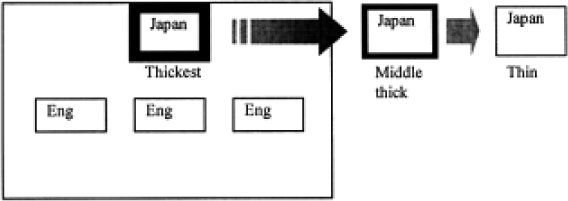
Three stages of a color contextual stimulus in thickness of the frame around a sample stimulus during the Testing Phase 4.
Table 1.
Apparent and Subtle Two-word sequence Contextual Stimuli
| Apparent | Subtle |
| Order/Dense | Order/Dense/Population/Groceries |
| Nature/Rare | Nature / Rare / Pure / Mature |
| Sharp / Instinct | Sharp / Instinct / Thin / Nothing |
Figure 5.
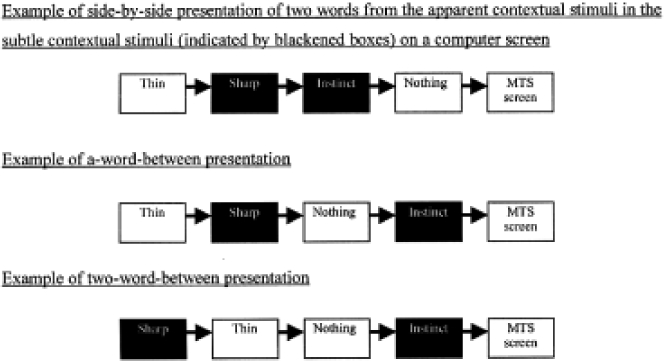
Three stages of a sequence contextual stimulus in word location of the two Japanese words within four Japanese words displayed immediately before the sample stimulus during the Testing Phase 4.
Independent variables. Contextual stimuli (background screen colors and two-word sequences) were varied from being easily discriminable (apparent) to being less noticeably different from each other (subtle).
Dependent variables. Like a number of studies in the second language literature, this study used accuracy (percent correct) and a temporal measure (response latency), as recorded in Testing Phases 3 and 4, as the indicators of language fluency (Andreou, Andreou, & Vlachos, in press; Kormos & Denes, 2004; McElree, Jia, & Litvak, 2000; Devitto & Burgess, 2004; Kotz & Elston-Guttler, 2004).
Results
Table 2 shows the aggregated data for all the participants. Figures 6a–c and Figures 7a–c show the representative graphs of primary (percent correct) and secondary (latency) dependent measures. Testing Phase 3 is referred to as the Apparent Phase, and Testing Phase 4 as the Subtle Phase in the tables, the graphs, and subsequent description. Within-session analysis in the Subtle Phase for primary and secondary measures was conducted for all the participants to identify the number of correct responses and average response latency in each block (i.e., six trials per block with a total of 324 trials), with respect to steepness of trend as well as standard deviations (Keppel, 1991). The purpose was to determine the possible influence of extraneous factors (see Table 3). Trials in the Subtle Phase were grouped into blocks of six for number of correct responses. The number of correct responses in each block of six was reported at the corresponding value (e.g., two correct responses in a given block were recorded as 2 for that block), indicating the overall steady state of responding.
Table 2.
Aggregated data for all the participants.
| Participant | # Trials | % Correct Response | Avg. Response Latency (s) | |
| Phase 1 | Phase 2 | |||
| 1 | 162 | 162 | 99 – 36 | 2.03 – 3.11 |
| 2 | 216 | 108 | 97 – 53 | 2.8 – 1.59 |
| 3 | 324 | 162 | 99 – 87 | 1.31 – 2.06 |
| 4 | 216 | 108 | 100 – 68 | 1.52 – 1.56 |
| 6 | 324 | 108 | 100 – 99 | 1.31 – 1.53 |
| 7 | 216 | 108 | 98 – 98 | 1.4 – 1.38 |
| 9 | 162 | 108 | 99 – 40 | 1.74 – 3.25 |
| 10 | 162 | 108 | 97 – 32 | 1.67 – 1.52 |
| 13 | 216 | 108 | 99 – 81 | 1.72 – 1.91 |
| 14 | 324 | 108 | 99 – 34 | 2.04 – 1.67 |
| 15 | 324 | 108 | 99 – 34 | 1.31 – 1.02 |
| 16 | 162 | 108 | 94 – 31 | 2.8 – 3.52 |
| 17 | 162 | 162 | 98 – 32 | 2.82 – 1.64 |
| 18 | 162 | 108 | 99 – 60 | 1.7 – 2.85 |
Figure 6a.
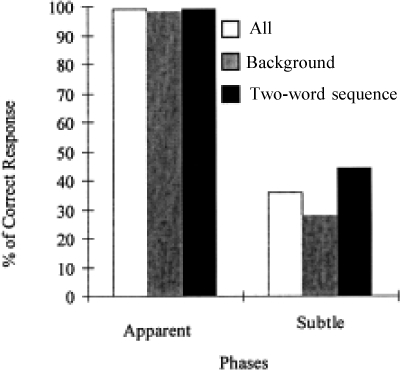
Representative graph (Participant 1) of decrease in accuracy from Apparent to Subtle phase. The component labeled as “Background” show data only in the presence of the background screen color contextual stimuli, and the component labeled as “Two-word sequence” show data only in the presence of the two-word sequence contextual stimuli. This applies to the subsequent figures 6 b–c and 7 a–c.
Figure 7a.
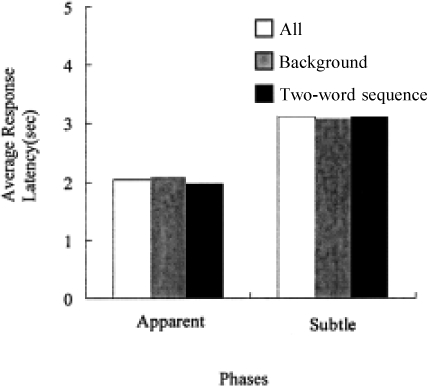
Representative graph (Participant 1) of increase in average response latency from Apparent to Subtle phase.
Table 3.
Values of trend and variability for the primary and secondary measures in subtle phase.
| Participant | Trend |
Variability |
||
| # Correct Responses | Avg. Response Latency | # Correct Responses | Avg. Response Latency | |
| 1 | −0.026 | 0.002 | 1.089 | 1.563 |
| 2 | −0.027 | −0.005 | 1.299 | 1.043 |
| 3 | −0.01 | −0.003 | 0.873 | 1.585 |
| 4 | −0.008 | −0.002 | 1.22 | 1.05 |
| 6 | −0.004 | −0.001 | 0.231 | 0.731 |
| 7 | −0.0001 | −0.001 | 0.351 | 0.796 |
| 9 | −0.024 | 0.024 | 1.393 | 22.55 |
| 10 | −0.014 | −0.001 | 0.957 | 1.255 |
| 13 | −0.02 | −0.002 | 1.005 | 1.813 |
| 14 | −0.021 | 0.001 | 1.071 | 1.544 |
| 15 | −0.003 | −0.002 | 1.115 | 0.476 |
| 16 | −0.007 | −0.019 | 1.972 | 4.77 |
| 17 | −0.017 | 0 | 1.043 | 1.27 |
| 18 | −0.004 | 0.002 | 1.104 | 2.344 |
Figure 6c.
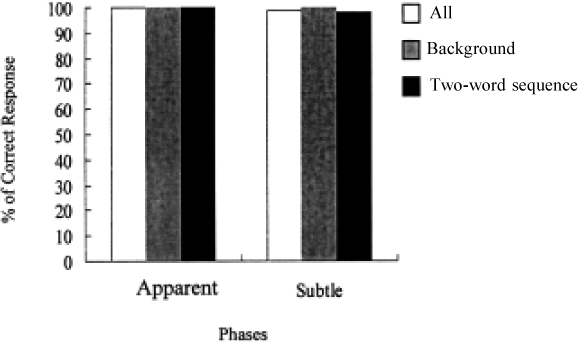
Representative graph (Participant 6) of no change in accuracy from Apparent to Subtle phase.
With regard to analysis of trend associated with the level of steepness, absolute values of trend were compared since they demonstrated the overall linear trend of responding across all trials or blocks with minimized discrepancies between a trend line and the actual data points (Keppel, 1991). Accordingly, the absolute values of zero or close to zero showed that there was no particular trend in responding across all trials or blocks in the Subtle phase. Figures 8a and b show sample graphs of trends for the two dependent variables. As indicated in Table 3, all participants showed a positive or negative trend less than 0.1 for dependent measures (percent correct and response latency). For standard deviations, zero indicated no deviation from the mean value. Accordingly, the standard deviations related to response accuracy indicated low variability across participants. As for the average response latency, with the exception of two participants (participants 9 and 16), the standard deviations were also consistently low.
Figure 8a.
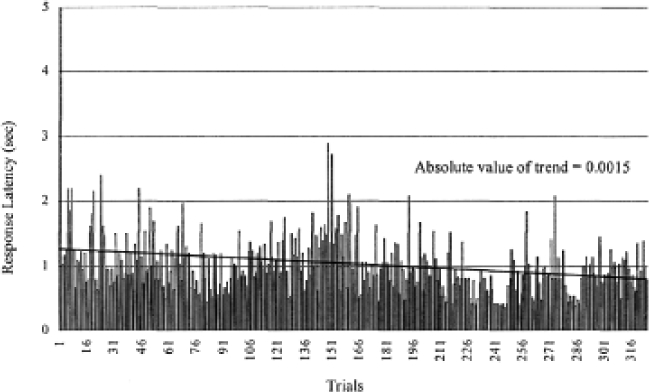
Sample graph (Participant 16) that shows a trend drawn across blocks for accuracy measure in Subtle phase.
Figure 8b.
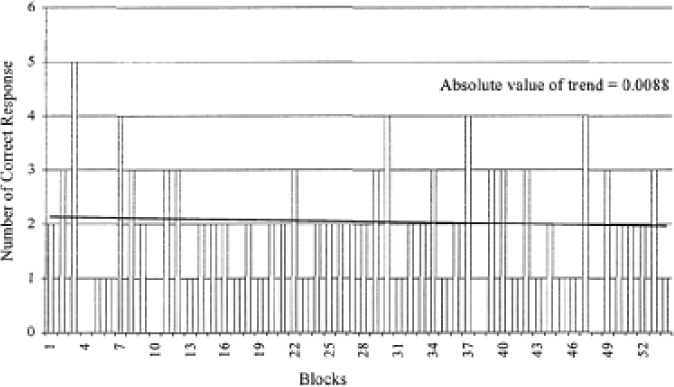
Sample graph (Participant 16) that shows a trend drawn across trials for response latency in Subtle phase.
With regard to standard deviations, zero indicated no deviation from the mean value. Accordingly, the standard deviations related to response accuracy indicated low variability across participants. As for the average response latency, with the exception of two participants (participants 9 and 16), the standard deviations were consistently low across the board.
Results for primary measure. Eleven out of fourteen participants (Participants 1, 2, 3, 4, 9, 10, 14, 15, 16, 17, and 18) showed a visible decrease in percent correct responding from the Apparent Phase to the Subtle Phase (see Figure 6a as the sample graph of a decrease in accuracy). One participant (Participant 13) showed partial decrease (see Figure 6b). The other two (Participants 6 and 7) did not show any change. These data correspond to those in Table 2 under “% of correct response from Apparent to Subtle.” In the within-session analysis for accuracy in the Subtle Phase, the data indicated low variability in responding across blocks.
Figure 6b.
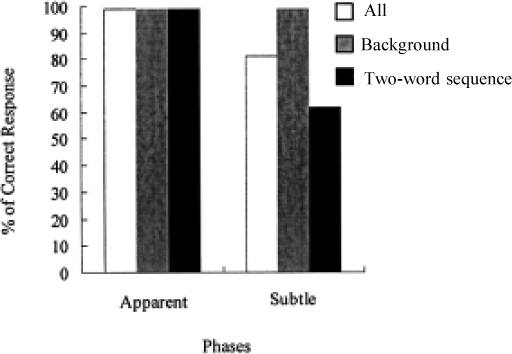
Representative graph (Participant 13) of partial decrease in accuracy from Apparent to Subtle phase.
Results for secondary measure. Five participants (Participants 1, 3, 9, 16, and 18) demonstrated a visible increase in average response latency from the Apparent Phase to the Subtle Phase (see Figure 7a as a sample graph of increase in average response latency). Four participants (Participants 4, 6, 7, and 13) showed a partial increase (see Figure 7b). The other five (2, 10, 14, 15, and 17) showed a decrease (see Figure 7c). These data correspond to those in Table 2 under “Average response latency (s) from Apparent to Subtle.” In the within-session analysis for response latency in the Subtle Phase, with the exception of two individuals (9 and 16), the standard deviations were consistently low and undifferentiated across the participants. No distinctive effects were observed for Participants 14 and 17 who completed the Apparent Phase halfway through in the first session and restarted the phase in the second session.
Figure 7b.
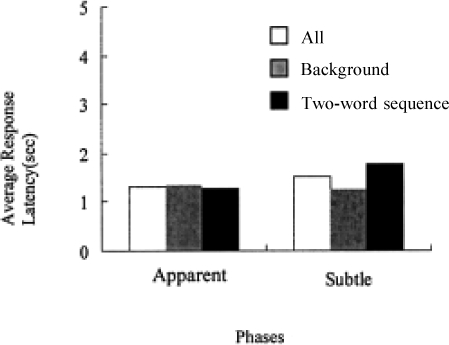
Representative graph (Participant 6) of partial increase in average response latency from Apparent to Subtle phase.
Figure 7c.
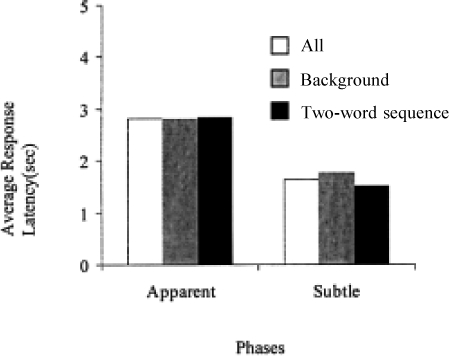
Representative graph (Participant 17) of decrease in average response latency from Apparent to Subtle phase.
Comparison of the first and second halves of data in the Subtle phase. In addition to the previously mentioned trend analysis and standard deviation, an analysis of average response accuracy and latency in the first and second halves of the Subtle Phase was conducted for each participant to investigate the influence of possible extraneous factors such as fatigue and duration of extinction. This analysis revealed a distinction between the two sets of data in terms of response latency only for Participant 9 (see Table 4). In general the data demonstrated a lack of differentiation across measures for the majority of participants.
Table 4.
Comparison of accuracy and speed measures at different periods in subtle phase.
| Participant | % Correct Response |
Avg. Response |
||
| after 183 Trials | after All Trials | after 183 Trials | after All Trials | |
| 1 | 0.399 | 0.358 | 2.903 | 3.114 |
| 2 | 0.574 | 0.528 | 1.931 | 1.59 |
| 3 | 0.891 | 0.88 | 2.379 | 2.062 |
| 4 | 0.683 | 0.676 | 1.653 | 1.561 |
| 6 | 0.984 | 0.991 | 1.564 | 1.53 |
| 7 | 0.989 | 0.985 | 1.456 | 1.383 |
| 9 | 0.426 | 0.398 | 1.759 | 3.248 |
| 10 | 0.333 | 0.318 | 1.944 | 1.517 |
| 13 | 0.781 | 0.806 | 2.033 | 1.909 |
| 14 | 0.388 | 0.343 | 1.645 | 1.669 |
| 15 | 0.344 | 0.34 | 1.142 | 1.016 |
| 16 | 0.317 | 0.312 | 4.954 | 3.524 |
| 17 | 0.361 | 0.321 | 1.649 | 1.635 |
| 18 | 0.623 | 0.605 | 3.262 | 2.846 |
Summary
The accuracy of responding (i.e., percent correct) as the primary measure showed a visible decrease in level from the Apparent to the Subtle Phase for most of the participants (11 participants for decrease and one participant for partial decrease). The response latency (secondary measure) increased from the Apparent Phase to the Subtle Phase for five participants. The data for four other participants showed partial increase, and the rest of five participants showed a decrease.
In the within-session analysis of trend in the Subtle Phase, all the participants showed values indicating a degree of trend less than 0.1 for dependent measures, demonstrating a steady state of responding (see Table 3) across all participants. With respect to variability, only Participant 9 and 16 showed a higher standard deviation than other participants for average response latency, suggesting that there would be an effect of extraneous variables such as fatigue and duration of extinction in only a few cases.
Discussion
These results showed that the contextual stimulus change in topography and number of variations significantly affected primary and secondary measures. In other words, the stimulus change in the Subtle Phase resulted in a decrease in response accuracy in a consistent manner. In addition, the change in response latency demonstrated some variation (majority of the participants experienced either increase or partial increase in the Subtle Phase.) This means that even if conditional discrimination training with the original contextual stimuli occurs, changes in contextual stimuli from the learning to the performance environments can have an important effect on accuracy and response latency in performance. Overall, the results of this study demonstrated the significance of the role of environmental stimuli for second language performance. The changes in accuracy and response latency are significant measures for the analog analysis of second language performance in natural contexts as brought up in the relevant literature (Devitto & Burgess, 2004; Kotz & Elston-Guttler, 2004). Although multiple variables including the individual's history and current emotional state may influence second language performance in the natural environment, this study showed that the stimulus change from the training to the performance environments will also be a significant factor for second language performance. Therefore, our findings may add some value to the current literature in second language performance by demonstrating the important role of environmental factors in language training.
The emphasis on the role of external stimuli in the environment may help second language learners or performers recognize the importance of the drastic environmental change that occurs when they transfer to the natural context. Knowledge of particular contextual cues with which they are in contact may prevent learners or performers from becoming discouraged when attempting to perform in the target environment. On the other hand, this knowledge may also help educators shift the focus to the external environment to arrange and influence performance of second language learners. They can set up programs that focus on the transition from instructional to target environment, such as the “immersion program” by Vesterbacka (1991). Further focus on environmental manipulation may also help educators as well as translators correctly respond to the different meanings of words in accordance with the associated contextual stimuli.
Osborne and Koppel (2001) used actual English words rather than nonsense words and demonstrated differential contextual control (i.e., thematic or taxonomic categorizations) over the set of English words. The current study in which actual Japanese and English words were used as samples and comparisons in conditional discrimination tasks supports the validity of their method. However, the use of nonsense words in addition to the arbitrary establishment of language (Houmanfar et al., 2005) could further enhance experimental control associated with the participants' history with a given language.
In summary, this study used the behavior analytic methodology of conditional discrimination by contextual stimuli to demonstrate the change in accuracy and response latency in second language performance that may result from the lack of transfer of training to the target environment. Accordingly, the change in salience (complexity) of contextual stimuli during the last phase caused a consistent decrease in accuracy among a majority of participants, and a change in response latency among all the participants. In short, the results demonstrated the significant role of contextual stimuli in the external environment with respect to change in second language performance. We hope these findings will also be useful to those who are interested more generally in transfer of training from instructional settings to other environments.
REFERENCES
- Andreou E, Andreou G, Vlachos F. Learning and Individual Differences. Studying orientations and performance on verbal fluency tasks in a second language. (in press) [Google Scholar]
- Batstone R. Contexts of engagement: A discourse perspective on “intake” and “pushed output.”. System. 2002;30:1–14. [Google Scholar]
- Bouton L. F. Conversational implicature in a second language: Learned slowly when not deliberately taught. Journal of Pragmatics. 1994;22:157–167. [Google Scholar]
- Bush K. M, Sidman M, Rose T. Contextual control of emergent equivalence relations. Journal of the Experimental Analysis of Behavior. 1989;51:29–45. doi: 10.1901/jeab.1989.51-29. [DOI] [PMC free article] [PubMed] [Google Scholar]
- Collentine J, Freed B. F. Learning context and its effects on second language acquisition: Introduction. Studies in Second Language Acquisition. 2004;26:153–171. [Google Scholar]
- Devitto Z, Burgess C. Theoretical and methodological implications of language experience and vocabulary skill: Priming of strongly and weakly associated words. Brain and Cognition. 2004;55:295–299. doi: 10.1016/j.bandc.2004.02.018. [DOI] [PubMed] [Google Scholar]
- Dibbets P, Maes J. H. R, Vossen J. M. H. Contextual dependencies in a stimulus equivalence paradigm. The Quarterly Journal of Experimental Psychology. 2002;55:97–119. doi: 10.1080/02724990143000180. [DOI] [PubMed] [Google Scholar]
- Dougher M, Perkins D. R, Greenway D, Koons A, Chiasson C. Contextual control of equivalence-based transformation of functions. Journal of the Experimental Analysis of Behavior. 2002;78:63–93. doi: 10.1901/jeab.2002.78-63. [DOI] [PMC free article] [PubMed] [Google Scholar]
- Green M. R. Contextual control of stimulus equivalence with preschool children (Doctoral dissertation, Utah State University, 1986) Dissertation Abstracts International. 1986;47:2652–2653. [Google Scholar]
- Griffee K, Dougher M. J. Contextual control of stimulus generalization and stimulus equivalence in hierarchical categorization. Journal of the Experimental Analysis of Behavior. 2002;78:433–447. doi: 10.1901/jeab.2002.78-433. [DOI] [PMC free article] [PubMed] [Google Scholar]
- Hamilton R. P. The insignificance of learners' errors: A philosophical investigation of the interlanguage hypothesis. Language & Communication. 2001;21:73–88. [Google Scholar]
- Hayes S. C, Kohlenberg B. S, Hayes L. J. The transfer of specific and general consequential functions through simple and conditional equivalence relations. Journal of the Experimental Analysis of Behavior. 1991;56:119–137. doi: 10.1901/jeab.1991.56-119. [DOI] [PMC free article] [PubMed] [Google Scholar]
- Herbst S. A, Houmanfar R, Washio Y. An experimental evaluation of optimal conditions for facilitating second language acquisition. University of Nevada; Reno: 2003. Unpublished master's thesis. [Google Scholar]
- Houmanfar R, Hayes L, Herbst S. A. An analog study of first language dominance and interference over second language. The Analysis of Verbal Behavior. 2005;21:75–98. doi: 10.1007/BF03393011. [DOI] [PMC free article] [PubMed] [Google Scholar]
- Huckin T. N, Jin Z. Inferring word-meaning from context: A study in second language acquisition. Proceedings of the Eastern States Conference on Linguistics. 1986;3:271–280. [Google Scholar]
- Kang S. The effects of a context-embedded approach to second-language vocabulary learning. System. 1995;23:43–55. [Google Scholar]
- Kecskes I. A cognitive-pragmatic approach to situation-bound utterances. Journal of Pragmatics. 2000;32:605–625. [Google Scholar]
- Keppel G. Design and analysis: A researcher's handbook. (3rd ed.) Englewood Cliffs, NJ: Prentice Hall; 1991. [Google Scholar]
- Kormos J, Denes M. Exploring measures and perceptions of fluency in the speech of second language learners. System. 2004;32:145–164. [Google Scholar]
- Kotz S. A, Elston-Guttler K. The role of proficiency on processing categorical and associative information in the L2 as revealed by reaction times and event-related brain potentials. Journal of Neurolinguistics. 2004;17:215–235. [Google Scholar]
- Larsen-Freeman D. Teaching language: From grammar to grammaring. Boston: Thomson Heinle; 2003. [Google Scholar]
- Liu M. Contextual enrichment through hypermedia technology: Implications for second-language learning. Computers in Human Behavior. 1995;11:439–450. [Google Scholar]
- Lochtman K. Oral corrective feedback in the foreign language classroom: How it affects interaction in analytic foreign language teaching. International Journal of Educational Research. 2002;37:271–283. [Google Scholar]
- Mackey A, Oliver R. Interactional feedback and children's L2 development. System. 2002;30:459–477. [Google Scholar]
- MacWhinney B. Implicit and explicit processes. Studies in Second Language Acquisition. 1997;19:277–281. [Google Scholar]
- McElree B, Jia G, Litvak A. The time course of conceptual processing in three bilingual populations. Journal of Memory and Language. 2000;42:229–254. [Google Scholar]
- Moeller A. K. Implications of research for second language learning and teaching. International Journal of Educational Research. 1995;23:649–652. [Google Scholar]
- Osborne J. G, Koppel L. Acquisition, generalization, and contextual control of taxonomic and thematic relational responding. Psychological Record. 2001;51:185–205. [Google Scholar]
- Oxford R. L, Scarcella R. C. Second language vocabulary learning among adults: State of the art in vocabulary instruction. System. 1994;22:231–243. [Google Scholar]
- Serna R. W, Perez-Gonzalez L. A. An analysis of generalized contextual control of conditional discriminations. Journal of the Experimental Analysis of Behavior. 2003;79:383–393. doi: 10.1901/jeab.2003.79-383. [DOI] [PMC free article] [PubMed] [Google Scholar]
- Sidman M, Tailby W. Conditional discrimination versus matching to sample: An expansion of the testing paradigm. Journal of the Experimental Analysis of Behavior. 1982;37:5–22. doi: 10.1901/jeab.1982.37-5. [DOI] [PMC free article] [PubMed] [Google Scholar]
- Steele D, Hayes S. Stimulus equivalence and arbitrarily applicable relational responding. Journal of the Experimental Analysis of Behavior. 1991;56:519–555. doi: 10.1901/jeab.1991.56-519. [DOI] [PMC free article] [PubMed] [Google Scholar]
- Swartzentruber D. Transfer of contextual control across similarly trained conditioned stimuli. Animal Learning & Behavior. 1993;21:14–22. [Google Scholar]
- Trillo J. R. The pragmatic fossilization of discourse markers in non-native speakers of English. Journal of Pragmatics. 2002;34:769–784. [Google Scholar]
- Vesterbacka S. Ritualised routines and L2 acquisition: Acquisition strategies in an immersion program. Journal of Multilingual and Multicultural Development. 1991;12:35–43. [Google Scholar]
- Word Association Thesaurus. http://www.eat.rl.ac.uk/ [Google Scholar]
- Wulfert E, Hayes S. Transfer of a conditional ordering response through conditional equivalence classes. Journal of the Experimental Analysis of Behavior. 1988;50:125–144. doi: 10.1901/jeab.1988.50-125. [DOI] [PMC free article] [PubMed] [Google Scholar]


